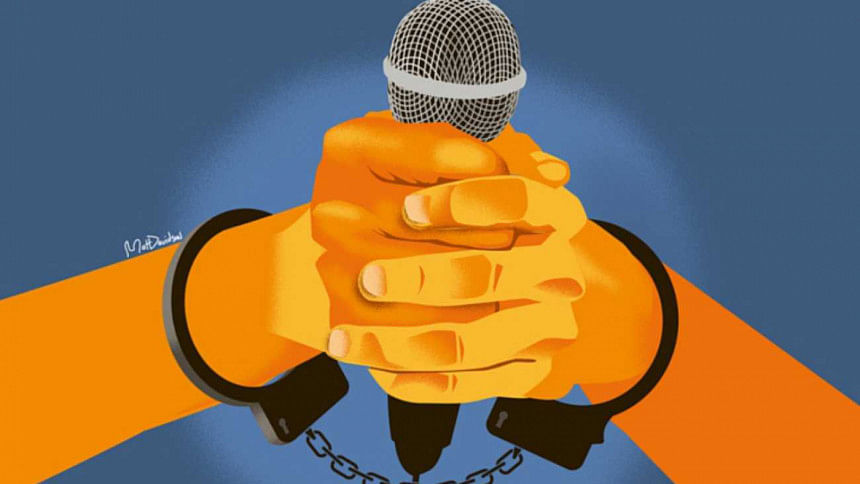Let the press do its job

As a commu-nication for development professional, I have always had an interest in press freedom and freedom of expression. While surfing the internet recently, I made an amazing discovery: the Department of Films and Publications (DFP) in its website boasted to have documented the historic March 7 speech of Bangabandhu Sheikh Mujibur Rahman. This courageous documentation took place during the rule of the Pakistani military regime. This is not just a lone example of upholding press freedom; we all know how journalists risked their lives and played a critically important role and contributed to our independence. The way they operated was similar to present day BBC which was established by a royal charter, and operates under its Agreement with the Secretary of State for Culture, Media and Sport.
As I write this piece, I am taking into consideration many issues which have been best told by my mentor Professor Rehman Sobhan who once said, "Today when I write an article, it takes me one week and five readings of censorship before I am ready to publish it. I have to think of every word I write today as everyone else in independent Bangladesh. But when we were fighting the martial law we could sit on the desk and write in two hours." Today, as we mark World Press Freedom Day, the world press stands at a crucial junction.
" Today, only 13 percent of the world's population enjoy a free press which includes an environment where media can report on political issues without fear or favour, journalists are not subject to any threat and their safety is guaranteed, state intervention is minimal and the press is not oppressed by legal and economic instruments.
According to Freedom of the Press 2017 findings commissioned by Freedom House, 2016 witnessed the decline of global press freedom to its lowest point in 13 years - journalists and media outlets in major democracies received unprecedented threats, and authoritarian states came up with new control mechanisms within and beyond their borders. Countries that witnessed the largest decline in press freedom are Poland, Turkey, Burundi, Hungary, Bolivia, Serbia, and the Democratic Republic of Congo. Today, only 13 percent of the world's population enjoy a free press which includes an environment where media can report on political issues without fear or favour, journalists are not subject to any threat and their safety is guaranteed, state intervention is minimal and the press is not oppressed by legal and economic instruments.
Shockingly, 45 percent of the world population live in countries where the media environment is 'Not Free'. Ten such countries and territories are Azerbaijan, Crimea, Cuba, Equatorial Guinea, Eritrea, Iran, North Korea, Syria, Turkmenistan, and Uzbekistan. In democracies like Poland and Hungary, politicians have undermined traditional media outlets, shaped the news by exerting their influence over public broadcasters, and raised the profile of 'friendly' private outlets. In the US, President Donald Trump lambasted some of the top media outlets for overshadowing the success of his first 100 days in office. He has previously disparaged the press, rejecting the news media's role in holding governments to account for their words and actions. In more authoritarian states like Venezuela, Turkey and Ethiopia, both political and social unrest have been used as a pretext to crack down on independent or opposition-oriented outlets. Governments in several countries in the Middle East, sub-Saharan Africa and Asia have extended restrictions by adopting fresh laws and policies, particularly targeting online media.
Over the years we have witnessed some laws being drafted or enacted that media practitioners and free thinkers consider as instruments to limit press freedom and freedom of expression. Although we have a number of civil society institutions that are directly linked with the press, none have been involved in the true sense in the formulation process of these laws. As a result, these institutions have not been able to serve the mandate for which they were created. For instance, Bangladesh Press Council (BPC) was established in 1979 under the Press Council Act, 1974. The objective was to meet the need for an independent authority for safeguarding the freedom of the press and protecting individuals and institutions from excesses by the media. Due to bureaucratic bottlenecks and age-old practices, the council has never been able to govern the press. Although the Act made BPC a quasi-judicial body with the authority to receive complaints made against newspapers or news agencies it gave no power to cancel the declaration of a newspaper. At present the office of the Additional District Magistrate issues declaration under the Printing Presses and Publication (Registration and Declaration) Act, 1973.
In 2015, the online press was puzzled when all of a sudden the Press Information Department (PID), the role of which had so far been limited to outreach, campaign and issuance of government notifications, asked the online press to apply for registration. As a result of this surprising move, there now exists an overpowering ambiguity regarding who really is in control of the press and who will protect it from various forms of attack and intrusion.
In the context of the Sustainable Development Goals (SDGs), we must make sincere efforts to attain target 10 of SDG 16 – dedicated to the promotion of peaceful and inclusive societies for sustainable development, the provision of access to justice for all, and building effective, accountable institutions at all levels. This is directly linked with people's right to access information and safety of journalists. There is no other alternative but to protect the fourth pillar of democracy (free media) through effective and independent press institutions.
The writer is a communication for development professional. E-mail: [email protected]





Comments